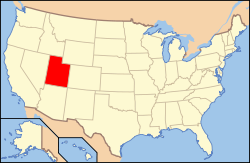Castle Dale, Utah
| Castle Dale, Utah | |
|---|---|
| City | |

Castle Dale's city hall
|
|
 Location in Emery County and the state of Utah |
|
 Location of Utah in the United States |
|
| Coordinates: 39°12′57″N 111°1′15″W / 39.21583°N 111.02083°WCoordinates: 39°12′57″N 111°1′15″W / 39.21583°N 111.02083°W | |
| Country | United States |
| State | Utah |
| County | Emery |
| Settled | 1877 |
| Incorporated | 1920 |
| Area | |
| • Total | 2.2 sq mi (5.6 km2) |
| • Land | 2.2 sq mi (5.6 km2) |
| • Water | 0.0 sq mi (0.0 km2) |
| Elevation | 5,676 ft (1,730 m) |
| Population (2010) | |
| • Total | 1,630 |
| • Density | 756/sq mi (291.8/km2) |
| Time zone | Mountain (MST) (UTC-7) |
| • Summer (DST) | MDT (UTC-6) |
| ZIP code | 84513 |
| Area code(s) | 435 |
| FIPS code | 49-10660 |
| GNIS feature ID | 1426380 |
Castle Dale is a city in Emery County, Utah, United States. The population was 1,630 at the 2010 census. It is the county seat of Emery County.
Castle Dale, the seat of Emery County government, is located on Cottonwood Creek in Castle Valley, a region of benchlands and river valleys bounded by the Wasatch Plateau to the west and the striking buttes, mesas, and canyons of the San Rafael Swell to the east. The high plateau barrier and the ruggedness of the Castle Valley landscape delayed settlement of the region until the late 1870s, when population growth and expanding livestock herds in Utah's central valleys stimulated a search for new agricultural and grazing lands. In 1875, brothers Orange Seely and Justus Wellington Seely, Jr., first brought the Mount Pleasant cooperative cattle and sheep herds to winter on Cottonwood Creek. On 22 August 1877 Brigham Young issued a formal call for settlers to locate in Castle Valley, the last such directive from the "Great Colonizer" before his death on 29 August. Orange Seely was appointed LDS bishop of the entire region east of the Wasatch Plateau, including present-day Emery, Carbon, and Grand counties. Local tradition describes Bishop Seely as a man of immense girth who made his pastoral rounds riding one mule and leading another laden with staple food items to be distributed to needy families, blacksmith tools for the shoeing of horses and sharpening of plowshares, and dental forceps to remove aching teeth.
The 1880 census found 237 people residing on homesteads strung along more than 6 miles (10 km) of Cottonwood Creek. In that year two townsites were surveyed, one known as Upper Castle Dale and the other as Lower Castle Dale. In 1882 Upper Castle Dale took the name Orangeville in honor of Orange Seely, even though he resided in the lower town. The two communities, only 3 miles (5 km) apart, have had closely related histories, but Castle Dale has been home to the main public institutions.
...
Wikipedia
